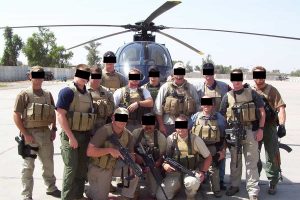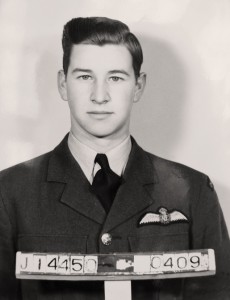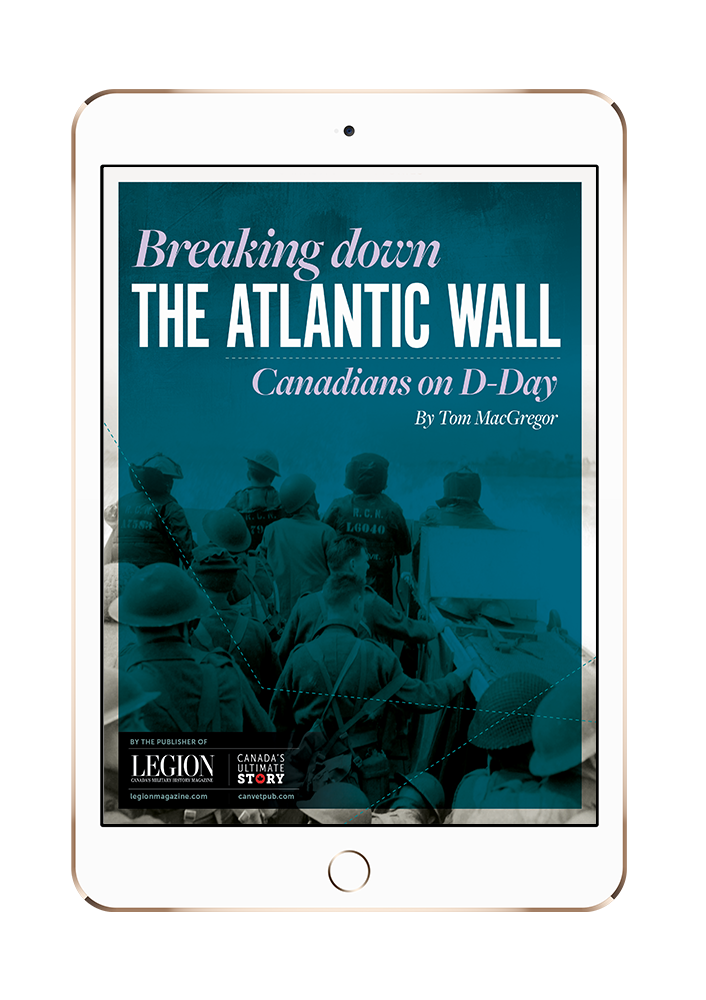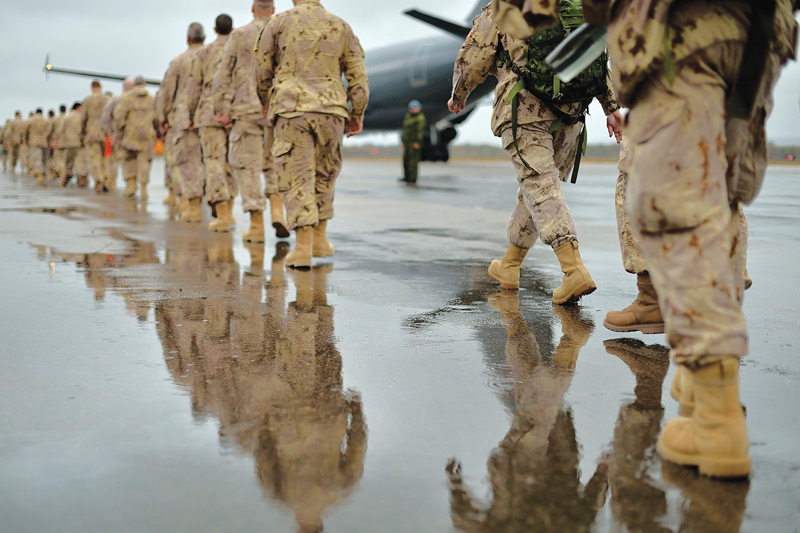
Canadian Armed Forces members board a C-150 Polaris at 14 Wing Greenwood, N.S., on Oct. 23, 2014, en route to the Middle East to support Operation Impact.[Eduardo Jorge/Canadian Armed Forces]
Having governed with an iron fist for 24 years, Assad’s ouster poses many challenges to security in the region. No sooner had the deposed dictator fled the country than both the U.S. and Israel launched waves of air strikes in the region aimed at destroying various weapons and other materiel that could be of use to terrorist organizations.
The U.S. also stated its purpose for the attacks was, in large part, to deny the Islamic State of Iraq and the Levant, also known as ISIL or ISIS, the opportunity to regain the influence it had in Syria a decade earlier. Even as ISIS lost its grip on lands within Syria and neighbouring Iraq, the U.S. had maintained a military presence to prevent any resurgence of its strength. Canada also maintained a military presence in Iraq, Jordan and Lebanon, intending to build its military capability to provide stability and security in the area. This mission was extended in 2023 to March 31, 2025.
The roots of Canada’s role can be traced back to September 2014 when an international coalition of 83 countries and five international institutions—the Arab League, the Community of Sahel-Saharan States, the European Union, Interpol and NATO—formed to defeat ISIS.
Originating in 1999, ISIS had a stated goal of creating a worldwide Islamic caliphate. It began to pursue this objective in the wake of national instabilities in Syria and Iraq in 2014. Advancing rapidly, its fighters—who came from all over the world, including Canada—captured Fallujah, Iraq, in January 2014, Mosul, Iraq, in June 2014, then advanced rapidly through other areas of Iraq and Syria.
Millions of people were displaced or brutally suppressed. Thousands died—either murdered by ISIS members or due to a rampant humanitarian crisis. Iraq’s already tenuous stability was undermined, and the geopolitical security of the Middle East at large was endangered.
The international response sought to defeat ISIS on all fronts. Its main impetus came on Aug. 7, 2014, when U.S. President Barack Obama authorized targeted military intervention in Iraq. This led to a campaign that supported Iraqis in pushing ISIS back from 98 per cent of the territory it had seized. Consequently, 7.7 million people were liberated from its oppressive occupation.
Key to that pushback was the deployment of coalition air assets in support of ground forces, mostly comprised of both government and non-government allies and coalition special forces units. Canada’s involvement at ground level included up to 830 Canadian Armed Forces personnel assigned to the Combined Joint Task Force-Operation Inherent Resolve. It was through this U.S.-led force that the multinational coalition focused operations on ISIS in Iraq and Syria.
Canada’s role in the air effort, meanwhile, was at first limited to the delivery of military supplies to Iraq. Between Aug. 28 and Sept. 26, 2014, Royal Canadian Air Force C-17 cargo planes made 25 flights to deliver 725,000 kilograms of donated military supplies.
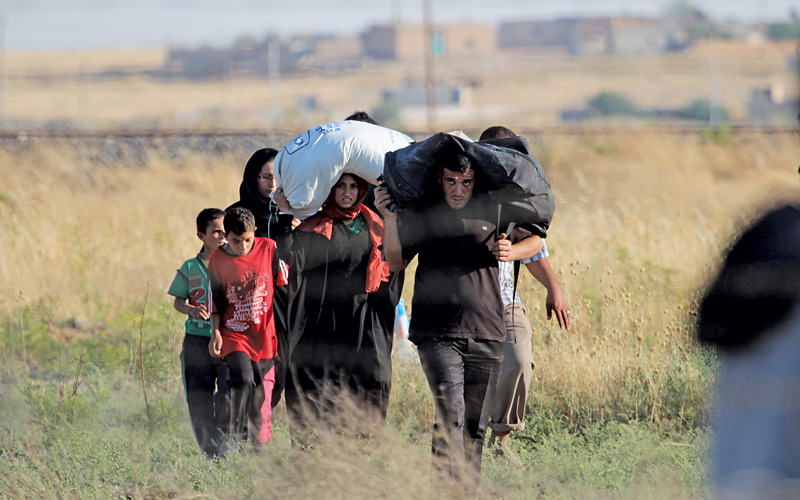
Supplies are unloaded from a Canadian Forces CC-177 at Ali Al Salem Air Base in Kuwait on Nov. 26, 2018 [Anadolu/Getty Images/479060452]
In the meantime, on Sept. 5, Prime Minister Stephen Harper announced that several dozen, mostly special operations forces, personnel would join U.S. forces in Iraq. Fourteen days later, the U.S. government requested that Canada provide additional support. Following an early October debate in the House of Commons, Canada approved RCAF warplanes to join coalition attacks on ISIS in Iraq.
The deployment happened quickly, implying that planning had already been well advanced for this role. On Oct. 28, six CF-18 Hornet fighter-bombers, a CC-150 Polaris aerial tanker and two CP-140 Aurora reconnaissance and surveillance aircraft arrived at Canada’s hub in Kuwait.
The fighters were initially from 4 Wing in Cold Lake, Alta., but a wing from Quebec also soon arrived. The CC-150 was from 8 Wing in Trenton, Ont., and the CP-140s came from 14 Wing in Greenwood, N.S. They began operations on Oct. 30.
The first mission was uneventful. Two Hornets flew a six-hour mission west of Baghdad and encountered no viable targets; a CP-140 spent six hours gathering intelligence over northwestern Iraq to develop a better sense of the battle space in which coalition aircraft would fight; and the Polaris delivered almost 50,000 pounds of fuel to coalition aircraft in about the same time span.
Canada’s air force had made its mark in the first day, integrating well into what was designated as the Middle East Stabilization Force.
On Nov. 2, two CF-18s destroyed ISIS targets identified as heavy engineering equipment and vehicles with GBU12 500-pound laser-guided bombs west of Fallujah. It was a four-hour mission requiring refueling from the Polaris. This was the first time CF-18 Hornets had dropped bombs against hostile targets since the 2011 war to oust Libya’s Muammar Gaddafi.
Operations continued almost daily thereafter, with Canadian aircraft supporting 8,000 troops from Iraqi security forces. The Iraqis launched a major offensive in late November to drive ISIS out of the Sinjar Mountains where many thousands of Yezidi refugees were sheltering.
The Canadians often struck ISIS targets, but they also helped deliver humanitarian relief. A prime example: on Nov. 20, CF-18s provided cover for a Royal Australian Air Force C-130J Hercules transport aircraft, which was bringing supplies to about 30,000 people trapped by ISIS in the mountains. Using parachutes, the Australians dropped basics such as food and water from low-flight levels. To protect the lumbering transport from surface-to-air missiles, the CF-18s flew nearby—ready to strike any detected launchers.
“After orbiting the area overhead and seeing people waiting for the drop from the Hercules, it was nice to finally see the pallets of aid touch the ground and see people rush out to retrieve them,” said a pilot from 425 Tactical Fighter Squadron, 3 Wing, in Bagotville, Que.
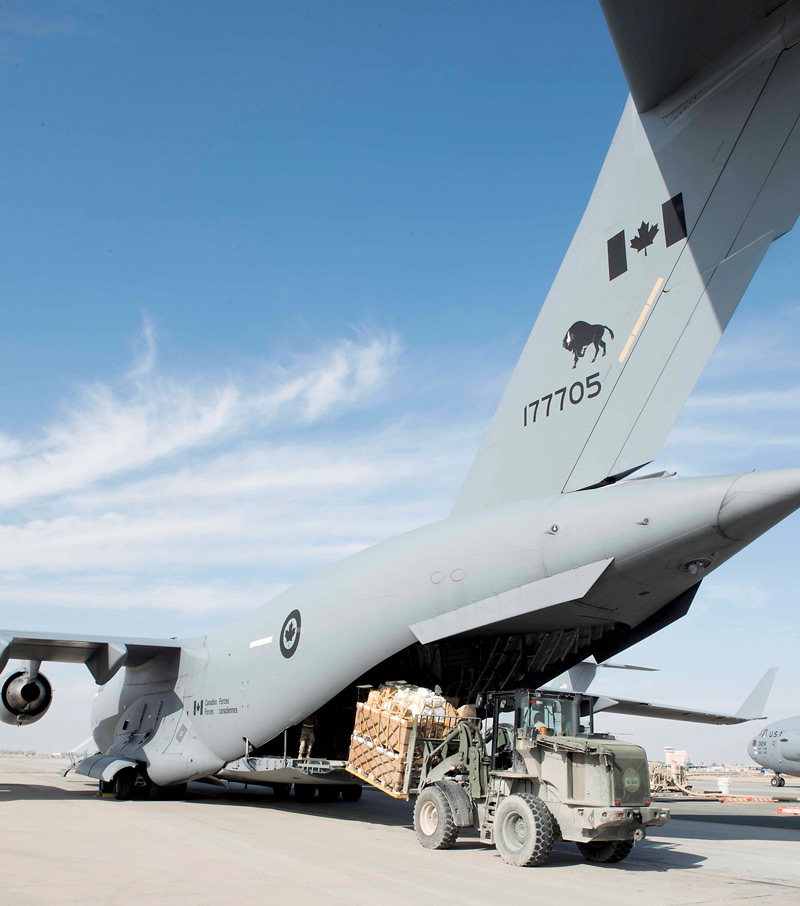
Syrian civilians flee to Turkey in June 2015 amid the Islamic State attacks. [Canadian Armed Forces]
CF-18 fighters also launched strikes with 500- and 2,000-pound bombs against heavy weapon positions, bunkers, ISIS vehicles and choke-point roadblocks along mountain roads.
“Given the Iraqi forces’ relatively light arms, it’s rewarding to contribute our heavy weapons to achieve effects on the ground,” said a 4 Wing pilot. It was his first overseas mission, and he found it “rewarding to employ my training after four years as a CF-18 pilot toward aiding in the defeat of an enemy like ISIL.”
Many of the targets had been identified by the long-range reconnaissance and surveillance Auroras. Their crews located them, then each was assigned to appropriate coalition air asset for an attack. Afterward, the Auroras would conduct battle damage assessments that either wrote off the target or confirmed the need for additional strikes.
“We had a high mission tempo during the operation and the technicians were working hard to make sure we got airborne,” reported one Aurora crew member. Once in the air, he said, the aircraft “has really been shining on this mission and our crew members have been able to maximize the effectiveness of the camera, radar, and other sensors in the fight. ISIL is having a hard time hiding.”
Enabling the CF-18s and other coalition fighter-bombers to remain close to the operations in the mountains, the Polaris air-to-air refuellers circled nearby, ready to offload hundreds of thousands of pounds of fuel to thirsty aircraft that otherwise would have had to return to base to tank up.
On Dec. 18—almost a month after the offensive began—reports that ISIS had been driven out of the Sinjar Mountains prompted a large exodus of Yazidi refugees out of the range. The following day, RCAF CF-18s struck ISIS vehicles and a hardened rocket emplacement between Mosul and Sinjar, near the town of Tal Afar. On Dec. 19, Iraqi forces reached the Sinjar Mountains and established a humanitarian corridor that enabled aid to flow through to those who remained trapped.
“Each day I flew over the area, you could see the line advancing as the Iraqi forces pushed forward,” recalled one CF-18 pilot. “You could also see a definite improvement in Iraqi forces’ abilities.”
While the December RCAF strikes focused on the Sinjar Mountains, other targets were also hit. On Dec. 21, an RCAF attack struck an ISIS improvised explosive device production factory and storage area in Fallujah.
With the new year, the campaign continued with sorties that struck terrorist targets on an almost daily basis through the summer. By September, however, the tempo slowed with monthly sortie rates ranging from 10 to 18.
In mid-November 2015, Iraqi security forces engaged in a drawn-out gunfight with ISIS outside the war-battered city of Kirkuk. ISIS fighters had pinned security troops down with heavy machine-gun fire when a pair of CF-18s roared in and dropped a bomb that missed the target. Although a guided munition, it malfunctioned and exploded in an open field. A day later, another strike near Mosul targeted an ISIS munitions factory. The bomb, however, struck off course—destroying the factory, but also a nearby dairy. Five to 13 civilians were killed.
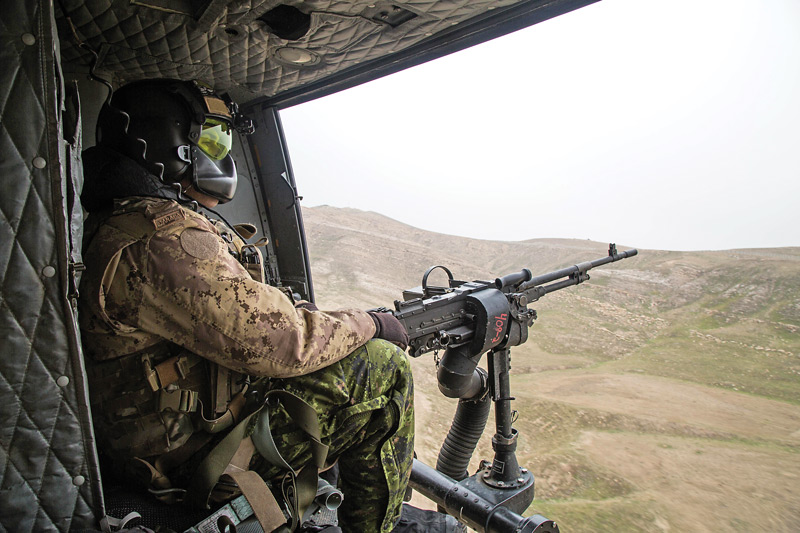
A gunner keeps watch from a CH-146 Griffon helicopter during a surveillance flight near Erbil, Iraq, on March 2, 2017. [U.S. Combat Camera/170302-JA380-051]
As early as January 2015, reports had surfaced that some other Canadian air strikes had also inadvertently struck civilian targets. This led to a Defence Department investigation into one particular incident, where between six and 27 Iraqi civilians may have been killed in a Jan. 21 bombing during a battle for a key highway near Mosul.
The CF-18 strike was aimed at a sniper/heavy machine-gun position on the roof of a building within an ISIS-held compound. Following the attack, a Kurdish fighter, allied with coalition forces, reported the civilian casualties to special forces operatives. Ultimately, the investigation concluded there was insufficient evidence to verify the allegation.
In a statement, Brigadier-General Lise Bourgon, commander of the Canadian mission, didn’t rule out the possibility of civilian casualties. “For the six months that I was there, I can tell you I saw no evidence that there were civilian casualties in a strike. Am I telling you that I can guarantee that there was not a civilian casualty? I’m not going to guarantee that.”
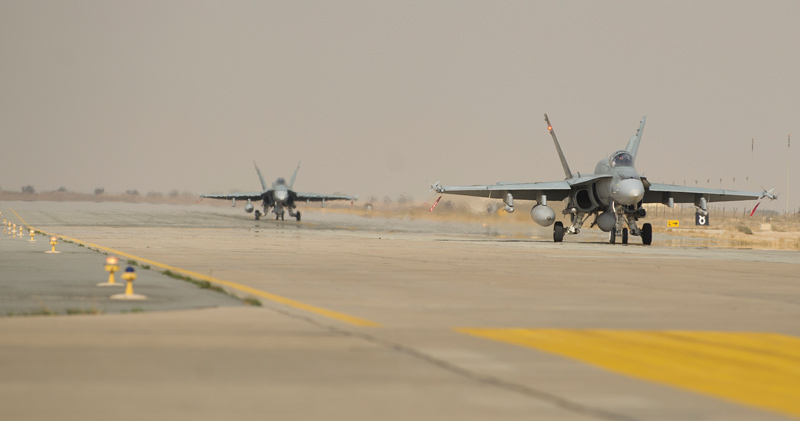
Two CF-18 Hornets taxi en route to an Operation Impact mission on Jan. 17, 2015.[DND/GD2015-0062-01]
During the 16-month Canadian air campaign, a total of 606 precision-guided bombs were released and the Defence Department reported that 17 of those had strayed off course. The RCAF said it had “no information” that any air strikes, either accurate or otherwise, killed or wounded civilians. Major Isabelle Bresse underscored that to the CBC.
“No weapons system is 100 percent accurate. On rare occasions, weapons systems are affected by meteorological conditions or experience malfunctions,” she said.
Canadian defence analyst Eric Morse added that that margin of error fit what should reasonably be expected from a mechanical point of view. “When you go into the granularities of warfare,” said Morse, “you begin to wonder how clean the hands must be and how clean they may be.”
It was undoubtedly that granularity that led recently elected Prime Minister Justin Trudeau’s government to end the air-combat mission on Feb. 15, 2016.
During the campaign, CF-18 Hornets flew 1,378 sorties, which included 251 air strikes—246 in Iraq and five in Syria. The 606 bombs were directed at 267 fighting positions, 102 equipment and vehicle targets and 30 military facilities.
The CP-140 Auroras, meanwhile, conducted 881 sorties through to Dec. 11, 2017, and the Polaris refuellers logged 1,166 sorties until Jan. 24, 2019. Since then, RCAF aircraft have continued moving cargo and personnel to support coalition operations in the area.
The decision to withdraw the CF-18s from a combat role in Iraq proved unpopular. Polls consistently showed that most Canadians disagreed with it. On April 4, 2017, Iraqi officials also expressed their displeasure with the withdrawal. Regardless, ISIS controls no territory in the Middle East today. But, it continues to operate as a terrorist organization—potentially ready to exploit any opportunity to reclaim its former prominence.
Advertisement











